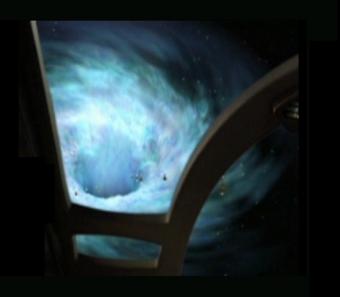
The Möbius Inversion is a small wormhole
characterized by level-6 subspace distortions and gravimetric shear. It
is located in the Delta Quadrant, where it covers the last third of the
course for the Antarian Trans-stellar Rally. In the 2377 running of the
Rally, high levels of radiation from the Möbius Inversion blocked
the sensors of the Delta Flyer. When it entered the Möbius
Inversion, its status from outside the wormhole was unknown. While in
the Möbius Inversion, the Delta Flyer reversed their deflector
polarity to deflect the shields of two rival vessels, creating a gap
for it to pass through and take the lead. (VOY: "Drive")
There have been various wormhole models developed in
real physics but none of them are named "Möbius Inversions".
Lorentzian wormholes are mainly studied in general relativity and
semiclassical gravity, while Euclidean wormholes are studied in
particle physics. Traversable wormholes are a special kind of
Lorentzian wormholes which would allow a human to travel from one side
of the wormhole to the other. Lorentzian wormholes known as
Schwarzschild wormholes or Einstein-Rosen bridges are bridges between
areas of space that can be modeled as vacuum solutions to the Einstein
field equations by combining models of a black hole and a white hole.
The name Möbius Inversion may have been conceived
by the writers of Star Trek as a homage to mathematician August
Möbius - a German mathematician and theoretical astronomer who is
best known for his discovery of the Möbius strip, a non-orientable
two-dimensional surface with only one side when embedded in
three-dimensional Euclidean space.
|
